Hafnium
- What is Hafnium
- Where is the Element Found
- History of Hafnium
- Classification and Position of the Element on the Periodic Table
- Properties of Hafnium [1, 2, 3, 4, 5, 6]
- Atomic Data of the Element [1, 2, 3, 7, 8, 9]
- What is Hafnium Used for
- Interesting Facts
- Potential Dangers and Health Hazards of the Element
- What is the Price of Hafnium
What is Hafnium
Hafnium (pronounced as HAF-nee-uhm) belongs to the family of transition metals, denoted by the chemical symbol Hf. It has thirty-two isotopes with known half-lives, of which only six exist naturally [1, 2].
Where is the Element Found
It is extracted from zircon ores whose major sources are heavy mineral sand ore deposits found in the USA, Malawi, Australia, and Brazil. Hf is also mined in other countries like India, China, Ukraine, and South Africa [11, 17].
History of Hafnium
Origin of its Name
Its name is derived from Hafnia, the Latin word for Copenhagen [2].
Who Discovered Hafnium
Dirk Coster, a Danish Chemist, and George Von Hevesy, a Hungarian chemist, discovered it in 1923 [3].
Where was it Discovered
The existence of the metal was initially predicted by the Russian Chemist Dmitri Mendeleev, who had mentioned in his book “The Periodic Law of the Chemical Elements” about an element having similar properties to titanium and zirconium, but heavier than them. In 1911, George Urbain, the discoverer of lutetium, assumed that the element 72 in the periodic table had been discovered by him through spectral analysis of rare earth elements and named it celtium. However, it was proved to be a mixture of lanthanides after three years.
In 1921, Neil Bohr advised Hevesy to analyze zirconium ores to discover the missing element. Two years later, Hevesy, along with Coster, used X-ray spectroscopy and discovered hafnium. Later in 1925, Anton Eduard van Arkel and Jan Hendrik de Boer determined a new method for producing pure hafnium crystals by decomposing hafnium tetraiodide (HfI4) on a white-hot tungsten filament [3].
Classification and Position of the Element on the Periodic Table
| Group | 4 |
| Period | 6 |
| Block | d |
Properties of Hafnium [1, 2, 3, 4, 5, 6]
General Properties |
|
| Atomic Weight | 178.49 |
| Molar Mass (g/mol) | 178.49 u ± 0.02 u |
Physical Properties |
|
| Color | Silver |
| Luster | Brilliant Silver |
| Odor | Unknown |
| Melting Point/Freezing Point (°C) | 2233 |
| Boiling Point (°C) | 4600 |
| Density (g/cm3) | 13.3 |
| State of Matter at Room Temperature/ Normal Phase (Solid, Liquid, or Gas) | Solid |
| Hardness (Mohs) | 5. 5 |
| Electrical Conductivity (Sm-1) | 3.4 × 106 |
| Work Function (eV) | 3.9 |
| Thermal (Heat) conductivity (W m-1 K-1) | 23.2 |
| Specific Heat (J/g K) | 0.14 |
Chemical Properties |
|
| Flammability | Flammable in fine powdered form |
| Oxidation state/Oxidation number | +2 +3 +4 |
Atomic Data of the Element [1, 2, 3, 7, 8, 9]
| Atomic Number | 72 | |||
| Valence Electrons | 5d2 6s2 | |||
| Quantum Numbers | ||||
| – n | 5 | |||
| – ℓ | 2 | |||
| – m ℓ | -2, -1 | |||
| – m s | +1/2, +1/2 | |||
| Electron Configuration | [Xe] 4f145d26s2 | |||
| Primary XPS Region | Hf4f | |||
| Crystal Structure | hexagonal | |||
| Lattice Constants (Parameters) | Unknown | |||
| Atomic Structure | ||||
| – Number of Electrons | 72 | |||
| – Number of Neutrons | 108 | |||
| – Number of Protons | 72 | |||
| Energy Levels | 6 | |||
| – First Energy Level | 2 | |||
| – Second Energy Level | 8 | |||
| – Third Energy Level | 18 | |||
| – Fourth Energy Level | 32 | |||
| – Fifth Energy Level | 10 | |||
| – Sixth Energy Level | 2 | |||
| Ionic Charge | Unknown | |||
| Radius of Atom | ||||
| – Atomic Radius (Å) | 2.23 | |||
| – Covalent Radius (Å) | 1.64 | |||
| Electron Affinity | 1.351 | |||
| Electronegativity | 1.3 | |||
| Ionization Energy | 1st | 2nd | 3rd | 4th |
| 658.519 | 1447 | 2248.1 | 3215.86 | |
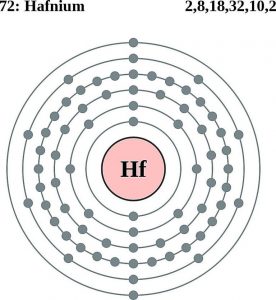
Hafnium Bohr Model
What is Hafnium Used for
- A good absorber of neutrons, Hf applies to making control rods of nuclear reactors such as those used in nuclear submarines [1, 2].
- It is used as a reactive material known as a getter in vacuum tubes for removing traces of gases like oxygen and nitrogen and other unwanted contaminates [2, 10, 11].
- It alloys with many metals, such as tantalum, iron, titanium, and niobium, which, in turn, have several other applications [2].
- The element is used in light bulb filaments, photographic flashbulbs, ceramics, and electronic equipment like cathodes and capacitors [3, 11].
- It is used in turbine blades and vanes of jet engines [28].
- The metal is a catalyst in many polymerization reactions [1].
- Hafnium has applications in welding torches and plasma cutting tips [5, 28], while hafnium carbide is useful as a lining for kilns and high-temperature furnaces, owing to their respective high melting points [3, 12].
- Apart from pure Hf wires, hafnium diselenide and disulfide are good semiconductors [16, 19, 20].
Interesting Facts
- An isomer of Hf, Hafnium-178-m2, has a half-life of thirty-one years, releasing its stored energy of 10,000 times as much as in one gram of TNT in the form of gamma rays, making it a potential bomb. However, no study has yet confirmed its usefulness as a nuclear grenade [14, 15]. Some researchers have also proposed its application as a gamma-ray laser [21].
- Since hafnium’s abundance in the earth’s crust is estimated to be 0.00033%, it’s not considered a rare earth metal [18].
- The beginning part of the electronic configuration of Hafnium is equivalent to the noble gas of the previous period, Xenon, and is abbreviated as [Xe] to keep the notation from getting too long [22].
Potential Dangers and Health Hazards of the Element
It may catch fire when in contact with moist air or water. Hf and its compounds may also cause eye, skin, and respiratory irritation. Prolonged exposure may have toxic effects on the lungs and liver [6].
What is the Price of Hafnium
The cost of Hf is somewhere between $100 and $130 per 100 grams.
References
- http://www.rsc.org/periodic-table/element/72/hafnium
- https://education.jlab.org/itselemental/ele072.html
- https://www.chemicool.com/elements/hafnium.html
- http://periodic.lanl.gov/72.shtml
- http://www.3rd1000.com/elements/Hafnium.htm
- https://pubchem.ncbi.nlm.nih.gov/compound/hafnium#section=Top
- https://environmentalchemistry.com/yogi/periodic/Hf.html
- http://chemistry-reference.com/q_elements.asp?Symbol=Hf
- http://hyperphysics.phy-astr.gsu.edu/hbase/pertab/Hf.html
- https://vacaero.com/information-resources/vac-aero-training/1166-getter-materials.html
- https://mineralseducationcoalition.org/elements/hafnium/
- https://www.azom.com/article.aspx?ArticleID=2292
- http://pubs.rsc.org/en/Content/ArticleLanding/2012/JM/c2jm33054g#!divAbstract
- https://www.globalsecurity.org/wmd/intro/hafnium.htm
- https://www.damninteresting.com/half-science-and-hafnium-bombs/
- https://www.americanelements.com/hafnium-wire-7440-58-6
- http://www.miningoilgasjobs.com.au/mining/rocks,-metals—gems/metals/hafnium.aspx
- http://periodictable.com/Properties/A/CrustAbundance.an.html
- http://www.hqgraphene.com/HfSe2.php
- http://www.hqgraphene.com/HfS2.php
- http://www.laserfocusworld.com/articles/print/volume-35/issue-3/world-news/newsbreaks/x-rays-trigger-gamma-rays-from-hafnium-isomer.html
- http://www.schoolmykids.com/learn/interactive-periodic-table/hf-hafnium/
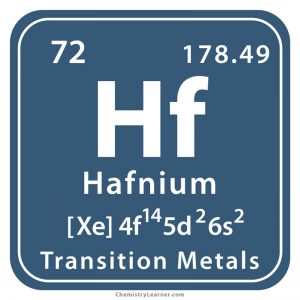
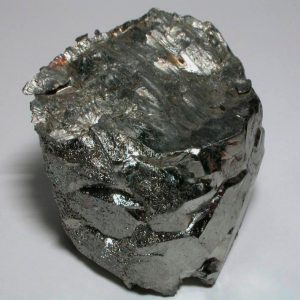
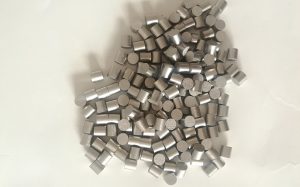
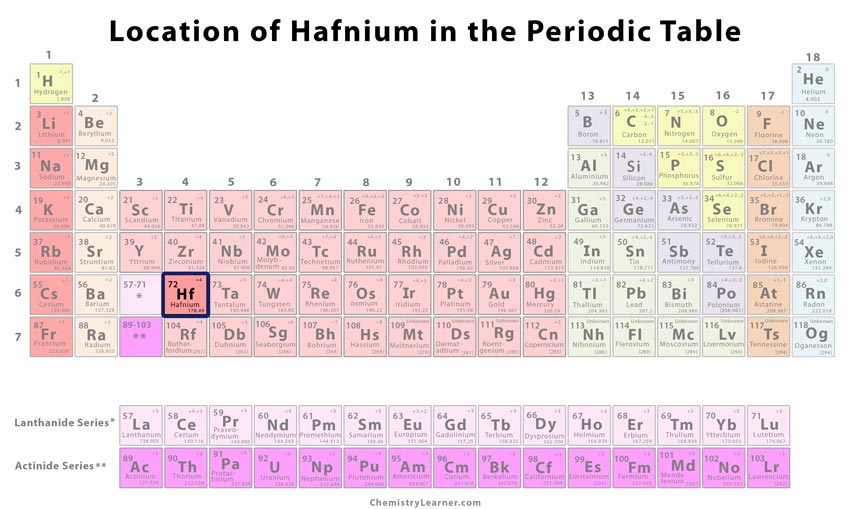
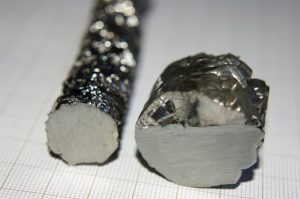
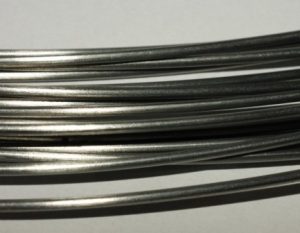
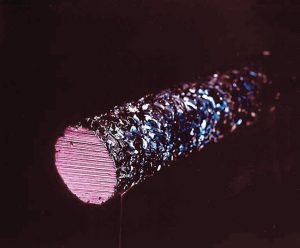
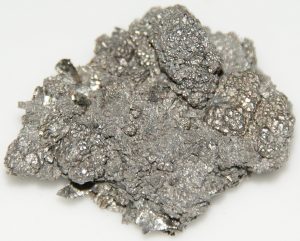





Thx for sharing
thanks for sharing such an information with us.
The quantum number ms is incorrect. If Hafnium is 5d2 then it had 5 orbitals and 2 electrons, so given that it will have 2/10 electrons it is +1/2 not -1/2 as the electrons will be facing up not down.
We appreciate your comment and have corrected the article.